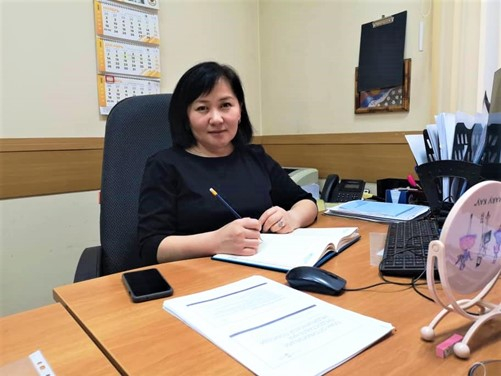Universal Nurse Pilot Reorganizes Workforce for COVID-19—And Beyond
Subtitle
Staffing model enables better health care with the same number of doctors and nurses
Date

Gulnaz Azhymambetova was one of the first nurses to graduate from a higher education nursing program in Kyrgyzstan. During a 2017 business trip to Lithuania, she observed that nurses there were involved in all stages of care during a patient’s entire stay in the hospital. She returned home determined to change nursing in Kyrgyzstan, where nurses’ duties are typically divided into three categories—ward, dressing, and procedure—and a nurse must defer to a doctor for even minor decisions.
Yet her push for a different division of labor didn’t gain traction until the COVID-19 pandemic in 2020. Hospital COVID-19 “red zones” began rapidly filling with patients who needed constant monitoring. Nurses, still constrained by duty categories and hierarchy, were stretched to cover as many as 40 patients each and were quickly overwhelmed.
A 2020 assessment led by the Ministry of Health found that basic care procedures for COVID-19 patients were not being followed, such as checking expiration dates on medicines, wiping patients’ skin twice with alcohol before an injection, and cleaning the filter of the oxygen concentrator. Nurses didn’t have time to introduce themselves to patients, explain procedures before doing them, or regularly monitor patients’ temperatures, blood pressure, and oxygen saturation.
“Working in the red zones and carrying out routine doctor's orders, the nurses were unable to conduct effective observation of patients due to lack of time,” said Ms. Azhymambetova, now the Ministry of Health and Social Development’s Leading Specialist in the Department of Organization of Medical Care and Public Health.
The problem, she explained, was the task-oriented human resources structure that assigned three different types of nurses, each with separate responsibilities, to care for a single patient. Under that model, when the patient load dramatically increased, it was impossible to properly attend to COVID-19 patients or coordinate care across the health worker team.
The solution was to implement a patient-centered approach.
Heading
From three nurse roles to one
From three nurse roles to one
Ms. Azhymambetova approached USAID’s Local Health System Sustainability Project (LHSS) for assistance in changing Kyrgyzstan’s nursing system. She and the LHSS team designed a pilot for three hospitals in the capital, Bishkek, focused on COVID-19 patient care in red zones and intensive care units. LHSS supported instruction of seven nurse-trainers and the development of job descriptions, checklists of new duties for nurses, and revised procedures. Under the pilot, nurses performed multiple duties for the same patient, and their workload was a much more manageable 8-12 patients in the general ward, or three in intensive care, instead of 40 or more.
"The Universal Nurse model contributes to pandemic preparedness as well as overall health system strengthening." -- Cholpon Asambaeva, LHSS Kyrgyzstan Country Director
“The functions of three types of physician-directed nurses were merged into one patient-centered nursing role called the Universal Nurse,” said Cholpon Asambaeva, LHSS country director and a clinician with human resources experience. “There is now an effective staffing model that allows us to have better health outcomes with the same number of doctors and nurses.”
This pilot built on nursing regulatory reforms approved before the pandemic, yet never implemented due to resistance from the physician community. Doctors accustomed to dictating the entire treatment process sometimes objected to the Universal Nurse model, said Ms. Azhymambetova. “I had to talk to the physicians to explain the usefulness of the innovation, that the patient should be at the center of all efforts and all activities of the nursing staff,” she said.
In all countries, medicine has historically been hierarchical, said Kate Greene, LHSS senior technical advisor for human resources for health. “But there’s increasing recognition globally that nursing, rather than just being a doctor’s assistant, is an autonomous practice in its own right.”
Three factors are driving this trend, Greene said: a shortfall of doctors in many countries, advocacy at the global and country level for strengthening the nursing profession, and a need for more efficient health service delivery. COVID-19 accelerated this trend, making it politically possible to adopt new models to meet demand.
Heading
Government will extend model to other hospitals
Government will extend model to other hospitals
In Kyrgyzstan, 75 nurses trained in the Universal Nurse model now work in the three pilot hospitals, and the Ministry of Health plans to include the Universal Nurse in its registry of positions. The ministry also plans to discuss additional pay for those in the role. In 2021-22, the ministry will expand the Universal Nurse model to all departments of the three pilot hospitals and then to two other COVID-19 hospitals in the south.
For LHSS’s part, “We hope to support the government in expanding this model to the primary care level to ensure that we have a patient-centered, effective health care workforce and are prepared to provide essential services for any future health care emergencies that may arise,” said Ms. Asambaeva. “The Universal Nurse model contributes to pandemic preparedness as well as overall health system strengthening.”
